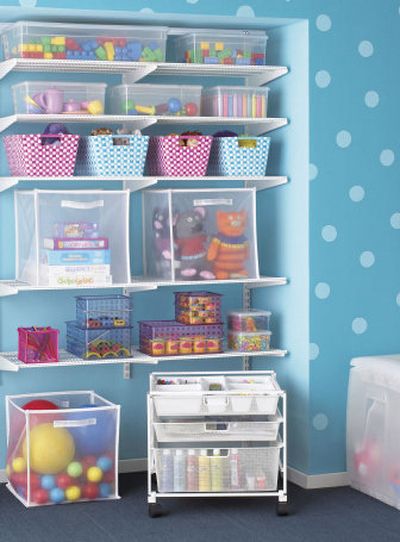Controlling clutter

It was a popular phrase in the 1980’s: “The one who dies with the most toys wins.” Judging by the clutter problems plaguing households across the country, a lot of Americans took that axiom seriously. An entire organization industry has sprung up around managing household clutter, but we still don’t appear to be winning the battle. Interior designers see clutter in nearly every home they visit, and they’re often called upon to creatively eliminate it. Where do they begin? Designer Janine Carendi recommends that clients walk through their home, to notice where they habitually put things and see where clutter gathers. According to Carendi and designers Brian Patrick Flynn and Mallory Mathison (all named to Domino magazine’s “Ten Decorators on the Verge” list this year), most homes have several major clutter spots in common. Fortunately, there are methods for taming the mess in each place.
Main point of entry
People arrive home thinking, ” ‘This is the checkpoint where I’m just gonna drop my stuff,’ ” so clutter quickly piles up there, Flynn says. He advises placing a cabinet or table just inside the door, with a large bowl or pretty basket on top, and dropping keys, sunglasses and mail in the bowl on arrival. Later, keys will be easy to find and miscellany can be dealt with when there is time.
Mathison suggests keeping woven baskets with lids (perhaps one for each family member) underneath the entryway table or covering the table with a cloth that extends to the floor, with baskets hidden below. Stash clutter there upon arriving home, then retrieve it later. A chest of drawers also works at the entryway, she says — put shoes in the bottom drawer, gloves and hats in another, then keys, cell phone and chargers in the top drawer.
Eliminate mail before it piles up, Carendi says, by keeping a pretty bin or basket at the entrance for recycling. It can be small and “doesn’t have to look like a recycling bin,” she says. The key is tossing junk mail right away, then adding it to your larger recycling bin later.
Kitchen counters
To banish clutter on kitchen workspaces, Carendi suggests keeping a large, lightweight basket at one end of a counter. Throw in everything that finds its way into the kitchen, then take the basket around the house once a week to put away or deal with the contents. Mathison agrees: A basket or a tray with several small bowls on it (for coins, keys, etc.) will “pull things together,” she says, creating “one common unifying surface, rather than having things scattered about.”
Flynn recommends using drawer inserts and organizers from Ikea or The Container Store, not just for silverware but for any drawers where small things go. One drawer can be designated for important things — pending bills, perhaps, or children’s homework — that would have otherwise gathered on the counter.
And the designers all suggest stashing small appliances inside cabinets, rather than keeping them on counters. You may forget about that waffle maker if it’s out of sight, they say, but your kitchen will look neater.
Bedside table
“Think about how it makes you feel to wake up in the morning and look over, and your bedside table is covered with clutter. It doesn’t give that sense of order you get” when things are organized, Mathison says. As with the kitchen, she suggests using small bowls and trays to tame clutter. Choose “a silver mint julep cup or maybe a small planter to hold your reading glasses, lip balm, your remote standing up straight. Then maybe use a small dish where you can put your rings and watch.”
Underneath the bedside table (or next to it, if your bedside surface is the top of a chest of drawers), use baskets to organize books, magazines and slippers. The items are still there, Mathison says, but the chaotic mess is gone.
Closets
Carendi says most closets are poorly designed: “A shelf over a bar, I find that to be the worst use of space ever invented. There’s so much negative space over the shelf.” Rip out what’s there and “customize according to your needs … with the Elfa system or something similar,” she says. “You don’t have to spend a fortune to reimagine your closet.”
Closets in guest rooms and babies’ rooms, says Flynn, are often haphazardly stuffed with items that are rarely used: “Things going into that closet often are decorative, like Christmas decorations, wrapping paper … or things like guest linens, guest towels, books, magazines.”
Take the closet doors off, he suggests, then paint inside of the closet the same color as the room or an accent color. Add a modular wire shelving system, then “style it like it’s a photo shoot,” he says. “You stack three towels on top of each other, and then books on a shelf, drawers with smaller things, guest slippers. It looks so good. You’ve totally taken something that could have been major mental clutter and now it’s something beautiful.”
And if your linen closet is overstuffed, says Flynn, display a half-dozen towels rolled up in a galvanized metal bin in your bathroom.
In every room of the house, say these designers, eliminating what you no longer need or want is a crucial step in battling clutter. If packing things up for donation or removing large furniture or appliances seems like a daunting task, Flynn suggests placing an ad online.
“These guys professionally get things for free on Craigslist and sell it later,” he says. “If you show them things you have, they’re like hungry dogs. They’ll take anything away.”